This painting was transferred to the museum from the State Literary Museum in April 1969. The old registration number — X 2672 — is barely visible. Its record states: ‘Tchaikovskaya Al. Andreyevna, the composer’s mother. Portrait by unknown artist of the 1840s’. At that time the museum housed a reproduction of this portrait, received in 1939 from the Klin Museum. The following was written in the record of this reproduction: “The portrait was found by relatives in the family collections and was donated to the Klin House-Museum of P. I. Tchaikovsky before 1939.”
Some researchers suggested that an unknown woman was depicted in the portrait, rather than Tchaikovsky’s mother, Alexandra d’Assier. However, the Tchaikovsky Museum in Klin published a photograph of Alexandra and Ilya Tchaikovsky taken in 1854, shortly before Alexandra Andreyevna’s death. It turned out that this portrait repeats many of the details of the picture, so the experts of the Estate Museum suggested that it was a posthumous portrait of Tchaikovsky’s mother, painted from the photo. Reproductions of the painting were most likely created as a memento for children.
At the end of 2017, the portrait was sent to the restoration workshops of the Udmurt Republican Museum of Fine Arts in Izhevsk. Restorer Tatiana Nikolaeva worked on the canvas.
Tchaikovsky’s mother Alexandra d’Assier, according to her contemporaries, was a tall stately woman not particularly beautiful, but eye-catching. “In family life Alexandra Andreyevna rarely demonstrated warm feelings and affections. She was very kind, but her kindness, in comparison to the constant friendliness of her husband to everyone and anyone, was strict, it manifested more in her actions, rather than words, ” Tchaikovsky”s brother Modest recalled.
Tchaikovsky loved his mother very much. The composer admitted that he could not listen to Alyabiev’s romance ‘The Nightingale’ (‘Solovey’) without tears, as he associated the melody with his mother’s singing, who died so young. In 1878 he wrote in a letter: “Denying the concept of the eternal life, I also reject with indignation the awful idea that I will never see those who are gone and who I love. Despite the triumphant power of my convictions, I will never reconcile myself with the thought that my mother, who I loved so much and who was such a wonderful person, has disappeared forever and that I shall never ever tell her that after twenty-three years of being apart I still love her.”
Some researchers suggested that an unknown woman was depicted in the portrait, rather than Tchaikovsky’s mother, Alexandra d’Assier. However, the Tchaikovsky Museum in Klin published a photograph of Alexandra and Ilya Tchaikovsky taken in 1854, shortly before Alexandra Andreyevna’s death. It turned out that this portrait repeats many of the details of the picture, so the experts of the Estate Museum suggested that it was a posthumous portrait of Tchaikovsky’s mother, painted from the photo. Reproductions of the painting were most likely created as a memento for children.
At the end of 2017, the portrait was sent to the restoration workshops of the Udmurt Republican Museum of Fine Arts in Izhevsk. Restorer Tatiana Nikolaeva worked on the canvas.
Tchaikovsky’s mother Alexandra d’Assier, according to her contemporaries, was a tall stately woman not particularly beautiful, but eye-catching. “In family life Alexandra Andreyevna rarely demonstrated warm feelings and affections. She was very kind, but her kindness, in comparison to the constant friendliness of her husband to everyone and anyone, was strict, it manifested more in her actions, rather than words, ” Tchaikovsky”s brother Modest recalled.
Tchaikovsky loved his mother very much. The composer admitted that he could not listen to Alyabiev’s romance ‘The Nightingale’ (‘Solovey’) without tears, as he associated the melody with his mother’s singing, who died so young. In 1878 he wrote in a letter: “Denying the concept of the eternal life, I also reject with indignation the awful idea that I will never see those who are gone and who I love. Despite the triumphant power of my convictions, I will never reconcile myself with the thought that my mother, who I loved so much and who was such a wonderful person, has disappeared forever and that I shall never ever tell her that after twenty-three years of being apart I still love her.”



